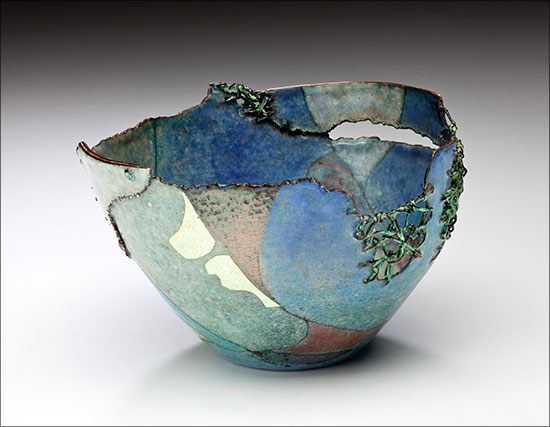Materials: enameled copper sheet, wire and rivets, silver foil
Dimensions: 4" x 4" x 6"
enameled copper destructed vessel form;
spun vessel, cut riveted and sewn
sifting, sgraffito, limoges enameling techniques
satin finished
Photo credit: Dan Kvitka
Judy Stone
El Cerrito, CA. USA
I have been working in my medium since 1972. Along the way I have developed a unique composite of enameling techniques based on the contemporary work of the late Fred Ball and the teaching of the late Bill Helwig. I work mainly on copper which I form by raising, spinning, and/or pressing in a hydraulic press. Some of the pieces are then electroformed or clad in thin copper sheet or mesh to add texture to the surfaces. Most of the vessel shapes are cut and then rejoined with woven copper wire, copper rivets, and copper tubing. I call these “destructed” vessels Burnt Offerings because they not only represent my homage to the medium and the power of heat and fire, but also they challenge me to heal what has been destroyed and hopefully make it more beautiful. The enamel imagery often suggests flaying or dissecting the innards of the piece to reveal what’s beneath. It also evokes place for me and that place is often in Greece or the US Southwest. The medium challenges me to burrow under its surface. I want the satin finishes to be handled and caressed. I want light to play on and through the pieces. At the moment when I fire each layer of enamel in a piece I give up control and let the heat of the kiln move the work in conjunction with the properties of the materials involved. Ultimately it is in giving up some control that I feel the most satisfaction.
These containers and vessels definitely hold their place in the world of stunning art objects as well as in the world of metalsmithing.
Since the dawn of time humans have created containers to hold things that were important to them, from large vessels to hold food and harvests to intimate containers for small precious things. They might hold memories, ashes, medicine, beverage, fruit or food - but all spring from the imagination and skill of the maker. Some have specific religious functions, some are meant for everyday use. When one thinks of a vessel or container the inclination is to think of something with solid walls - yet many of these works involve the exploration of positive and negative space, and the use of negative space to help create the illusion of the wall of the vessel.
As the world’s largest jewelry related internet site, Ganoksin strives to develop exhibitions showcasing work from around the world. This exhibition was open to all metalsmiths, professional and amateur, advanced and beginner. Participants are from The Netherlands, the USA, Canada, Australia, Costa Rica, the United Kingdom, Israel, Hong Kong, Colombia, Romania, Italy, Ireland, Japan, Malaysia and Denmark. While most of the pieces are by an individual metalsmith, some are collaborations, one of three artists spanning 50 years.
In total 319 artists contributed 729 show pieces for the permanent online exhibition.
Objects in the exhibition include boxes, lockets, urns, ash containers, bowls, wine cups, reliquaries, match holders, vases, teapots, pitchers, sugar bowls, baskets, nests, pillboxes, clutches and a range of sculptural forms. A variety of techniques are showcased covering a wide range of metalsmithing techniques. Materials used include everything from gold and silver to less expensive metals. Ornamentation includes the addition of enamel, chasing and repousse’, gemstones and found objects.
The exhibition was curated by Beth Wicker, President of the North Carolina Society of Goldsmiths in the United States, and Adjunct Instructor at Northeastern Technical College in South Carolina. Director of the exhibition is Hanuman Aspler, founder of The Ganoksin Project, the world’s largest internet jewelry site.
